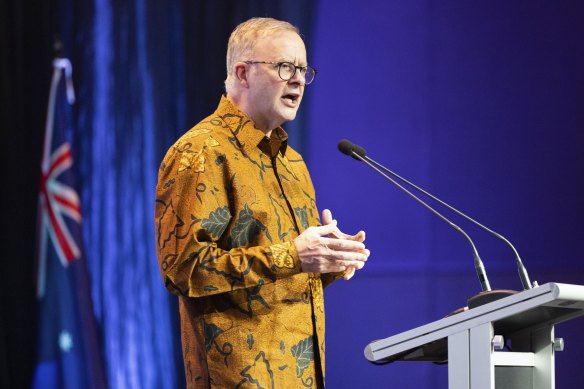‘Underweight and stagnant’: Australia urged to lift South-East Asia focus

Save articles for later
Add articles to your saved list and come back to them any time.
Australia will miss out on the massive opportunities opened up by South-East Asia’s economic boom unless the federal government slashes red tape, simplifies visa requirements and increases awareness of the region, a major report has warned.
Prime Minister Anthony Albanese will release the government’s South-East Asia Strategy, which contains 75 recommendations for improving economic ties with the region, during a trip to Jakarta on Wednesday.
Anthony Albanese, pictured here in Indonesia last year, will release the government’s South-East Asia strategy during a trip to Jakarta on Wednesday.Credit: Alex Ellinghausen
The strategy, developed by former Macquarie Group chief executive Nicholas Moore, recommends the government explore introducing a “political risk insurance” scheme to make it easier for Australian businesses to invest in politically unstable countries.
The government believes attracting more investment from South-East Asia will be crucial to ensure the nation does not become overly dependent on trade with China.
The report says while Australia’s trade with the region has grown in nominal terms over the past 20 years, the proportion of total trade has remained constant at around 14 per cent.
“Australian investment in the region is underweight, and growth in foreign direct investment has stagnated in the past decade,” the report says.
“Australia’s trade and investment growth with the region have not kept pace with South-East Asia’s economic growth over the past 20 years.”
Albanese said South-East Asia’s fast-growing economies presented a major opportunity for Australian business.
“Our economic future lies with South-East Asia. This strategy outlines how we can harness this growth and seize the vast trade and investment opportunities our region presents,” he said.
Albanese will address the strategy in a speech to the ASEAN Indo-Pacific Forum before holding bilateral meetings with Laotian Prime Minister Sonexay Siphandone, Timor-Leste’s Prime Minister Xanana Gusmao, Canadian Prime Minister Justin Trudeau and Malaysian Prime Minister Anwar Ibrahim.
By 2040 the report says South-East Asia as a bloc is projected to become the world’s fourth-largest economy behind the United States, China and India, while the potential consumer market is expected to be 10 times larger than Australia’s.
The region will require $3 trillion in infrastructure investment as its population expands and the middle class grows, opening major opportunities for Australian investors.
One of the most significant risks faced by foreign investors in South-East Asian countries is governance and regulatory uncertainty.
A political risk insurance scheme that allows investors to share risks with government agencies could encourage firms to invest in countries and projects with higher political risks, the report says.
It also says the government should explore opportunities to reduce regulatory burdens under the Foreign Investment Review Board and establish a one-stop shop, known as a single-door concierge service, to encourage inward foreign investment.
The government has not released its response to the report.
“The Albanese government is deploying all elements of our national power to make Australia stronger and more influential in the world, including by deepening our engagement in the region,” Foreign Minister Penny Wong said.
“Investing in priority sectors such as the green energy transition, infrastructure and food security is an investment in Australia’s future and the future of the region.”
Cut through the noise of federal politics with news, views and expert analysis. Subscribers can sign up to our weekly Inside Politics newsletter here.
Most Viewed in Politics
From our partners
Source: Read Full Article
